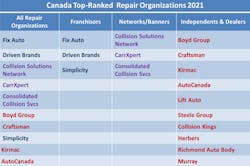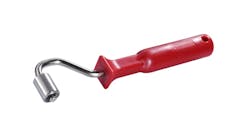The 16th annual white paper, A 2021 Profile of the Evolving U.S. and Canadian Collision Repair Marketplace, is now available.
The pinnacle year for the collision repair industry was 2019 with an all-time high TAM of $38.3 billion. Repair facilities were flush with repairable vehicles and had the manpower and parts to service the demand. The recovery years of 2021 and 2022 were and continue to be awkward and choppy as the collision repair industry attempts to bounce back within the constructs of numerous macro industry challenges and opportunities, U.S. economic and geo-political headwinds despite the many post-pandemic recovery advances within the collision repair industry and throughout the broader interconnected auto physical damage landscape. In 2021, despite a continued reduction in repairable claims, the industry’s TAM recovered to $38.6 billion despite fewer repairable claims which were primarily supported by an offset increase in higher severity.
Collision repair industry
- From the beginning of the pandemic in 2020 and continuing throughout 2022, demand for collision repair services exceeded technician capacity for most of the larger MLO consolidators the U.S. and Canadian markets, which resulted in high levels of work-in-process. We see this extending into 2023 due to the continuing labor shortage. It is not a matter of demand, but a supply side lack of labor availability.
- Labor shortages and technician skill deficiencies are creating competition to acquire those who are interested in receiving training to improve their skill levels. This situation is consequently increasing technician acquisition, retention, and benefit costs.
- Insurance carriers have taken additional steps to increase premiums to cover their rising costs. Historically, repairers had a difficult time pursuing labor rates with insurers. Today, the collision repair industry is aggressively pursuing labor rate increases and is hopeful that insurer premium increases will allow for their labor rate increases.
- Insurance carriers, which continue to account for a significant volume of claims to repairers, tend to favor MSOs that offer largely predictive and standardized outcomes.
- We do see a nascent movement by several MLOs to move away from DRP relationships while opting into a predominantly OEM certification preference model.
- MLO scale remains a competitive advantage.
- The groundswell of support and adoption of OEM repair standards continues to emerge as the preferred norm. However, the degree of influence and control by the OEMs in directing business remains limited. There is a better near-term chance for ROI with premium and luxury brands today due to their more active involvement and adherence to program standards and processes influencing where cars are repaired.
- Vehicle telematics will become a more influential factor in the future control of the claims process.
- Electric vehicle sales are trending upward toward 10 percent of new car sales by YE 2022. We expect EV sales to increase to between 30 and 40 percent of sales by 2030.
- Despite the expectation of the onslaught of EVs, range anxiety will need to be addressed and overcome through increasing battery range capability coupled with growing the number of charging stations nationally.
- Full digitalization of the estimating process for qualified repairable claims starts with less complex repairs and eventually migrates to more complex damaged vehicles. The journey starts with photos and evolves to telematics, reliance on artificial intelligence coupled with insurer-driven rules, and integration of supplier network connections. This throughput connected process will automatically initiate and populate the line-item detail necessary for predictive and actionable estimates.
- Continued evolution of business segmentation strategies will have the largest consolidators marketing their “one national shop model/platform” to insurers, boosting a large marketplace network of available collision repair locations throughout the U.S. This one-national-shop model is further segmented within markets by various clusters of collision repair locations that can provide a broad range of segmented capabilities able to satisfy a wide range of repair types including:
Glass installation
Express same or next-day service
Non-drivable/total-loss processing and disposition
OEM standards and luxury model certification
Advanced material repair
Mechanical repair
Diagnostic services including pre- and post-repair scanning and calibration
Partnering and operating dealership collision repair centers
Private equity continues to be highly committed to the collision repair industry. MLOs will continue to aggressively acquire and merge. Consolidation is active within all auto physical damage segments. There remains much opportunity for further consolidation and continued private equity investment. Despite the growing market share of the larger platforms and segments we track and analyze, there is still a long tail of smaller independent repairer fragmentation in the market which will be the basis for the next wave of industry contraction and consolidation.
Multiple location operator, MLO, consolidation
Within the broader automotive aftermarket landscape, private equity and institutional capital continue to invest in most of the satellite segments surrounding the collision repair industry such as parts, paint, body and equipment (PBE), tire outlets, carwashes, dealerships, and technology. Comparing the first six months of 2022 to the same period in 2021, we saw an unusually slow period for MLO collision repair acquisitions by most consolidators with Crash Champions and Classic Collision being the exceptions. Both Crash Champions and Classic Collision will most likely advance in the ranking at year end 2022. While Caliber and Gerber did acquire some MLOs during this time period, much of their expansion was through single-location acquisitions, brownfields, and greenfields. The most significant acquisition event of 2022 came in July when Crash Champions announced its transaction with Service King with its new private equity partner Clearlake Capital.
Canadian market
Canada tried to reopen in early 2021, but efforts stalled. Through June of 2021, business continued to be down around 50 percent, although it did slowly improve throughout the remainder of the year. By mid-2022, Canada was almost back to normal. Most Canadians view 2020 and 2021 as some of the most challenging times for society and the collision repair business. The restrictions were very disruptive and fundamentally impacted the health and viability of the collision repair industry, causing repairers to consider their future in the industry.
When ranking all types of repair organizations, the first two positions in the All-Repairers ranking are represented by Franchisors with the following three being Network/Banner organizations. The remaining five companies reflect three independents, Boyd, Craftsman, and Kirmac; one dealer, AutoCanada, and one franchisor, Simplicity.
There are a number of secular trends that exist today that will continue to have a material impact and influence on the collision repair industry and within the broader auto physical damage industry segments.
- Insurtech claims processing operating models reinforce insurers’ preferred business economics which frequently is at odds with the OEM repair model.
- Vehicle damage estimation with photos evolving to vehicle telematics, relying on artificial intelligence coupled with insurer-driven rules with integration of supplier network connections.
- U.S.-Canada trans-border market entrance as reflected by companies such as:
Collision Solutions Network, which merged in mid 2020 with 1 Collision in the U.S with its continued onboarding of new members
Fix Auto with ProColor entering the U. S in early 2021 with its expanding franchise network in 2021 and 2022
Lithia Dealership Group entering Canada with the acquisition of Pflaff Automotive Dealer Group
- OEM certification programs’ continued evolution, importance, and involvement in collision repair.
Our five-year forecast to 2026 has the ≥$20 million segment and the Top 3 Consolidators aggressively growing their businesses while maintaining their significant market share lead over the Franchise Networks and the $10-$19M MLO segments. We expect that by 2026, the Top 3 Consolidators will grow from their 2021 market share of 18.4 percent so between 24 and 28 percent. Our annual report, A 2021 Profile of the Evolving U.S. and Canada Collision Repair Marketplace, is now available. The report contains the complete results of our research and analysis for 2021, including over 90 charts and graphs throughout more than 130 pages with historical trends and a future view.




